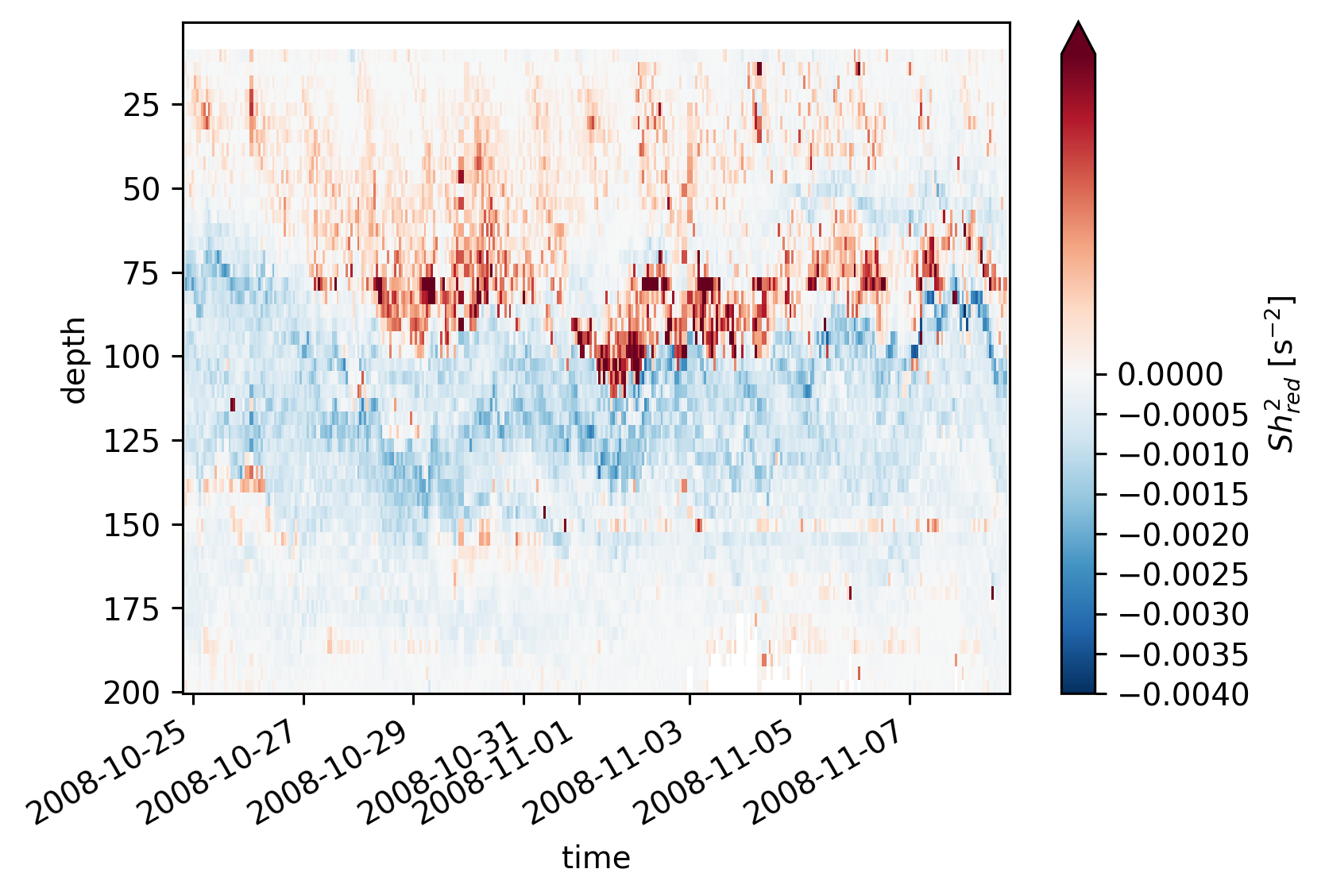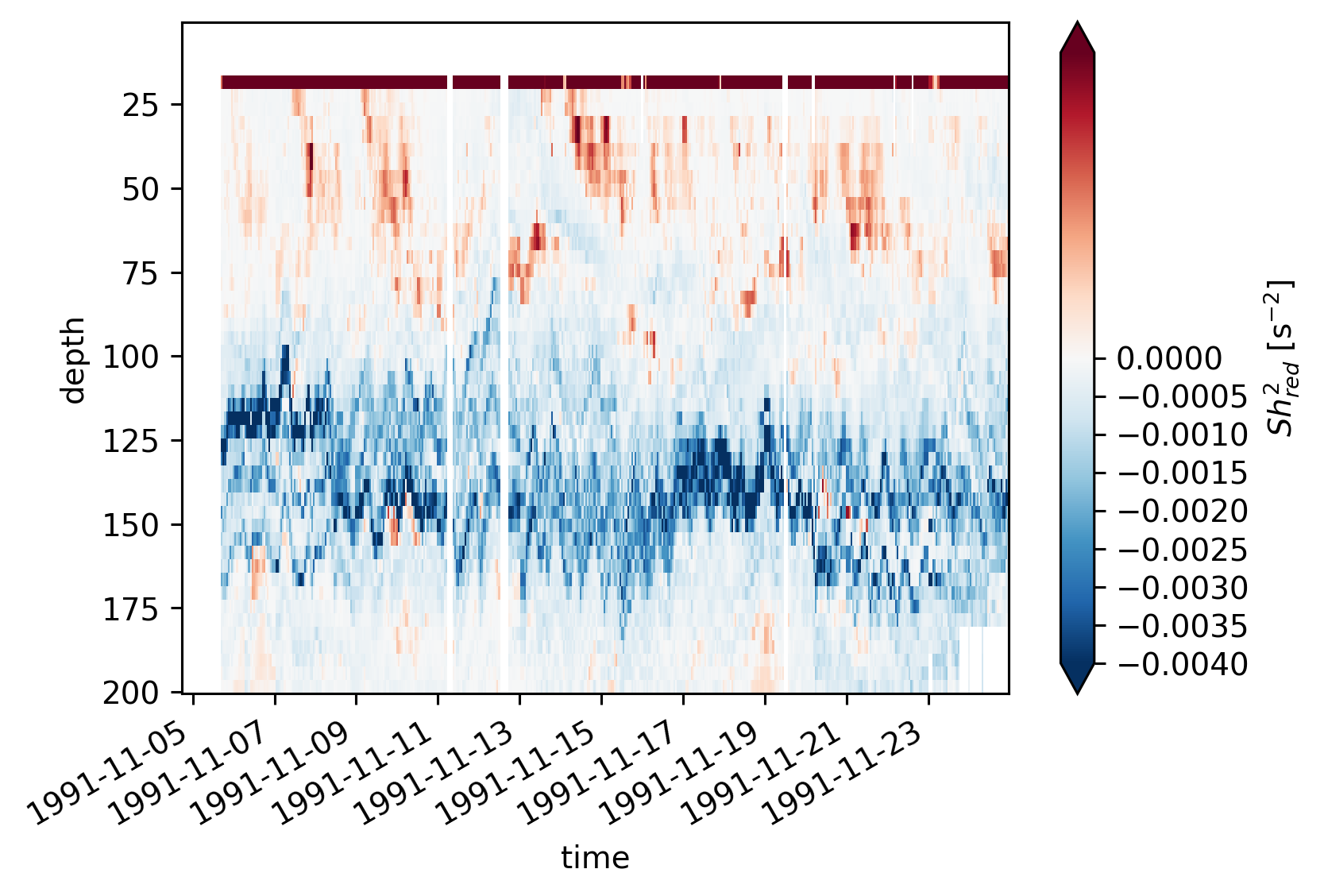Variations in \(Ri_f\), \(Γ\)#
Γ is potentially a large uncertainty in \(J_q^ε\). Lets try the analysis of Monismith et al (2016). Definitions:
\begin{align*} Ri_f &= \frac{B}{B + ε} \ Re_b &= \frac{ε}{νN^2} \ B &= \frac{χ}{2} \frac{N^2}{T_z^2} = K_Tb_z \ Γ &= \frac{Ri_f}{1 - Ri_f} \end{align*}
I’m calculating these after
thorpe-sorting T, S, ε, χ by ρ,
then averaging to 1Hr,
then fitting slopes or calculating means in 5m bins
Averaging tends to raise mean \(Ri_f\) values for TIWE.
I’ll look at EQUIX and TIWE.
Quoting Monismith et al (2016):
more generally B + ε represents the net supply of TKE including tke production \(P\), vertical divergence of TKE flux, and the rate of change of TKE with time.
Ivey et al (2008) say the following but the data is from Shi et al (2005) so do we still believe this?
Both laboratory and DNS work indicate that at these extremes, when either \(ε/ν N^2\) ∼ O(1) or \(ε/νN^2 ∼ O(10^5)\), the mixing efficiency \(Ri_f\) → 0 and the use of large \(Ri_f ≈ 0.2\) in field situations in these limits cannot be justified.
Show code cell content
%load_ext watermark
%load_ext snakeviz
%matplotlib inline
import glob
import os
import cf_xarray as cfxr
import datatree
import dcpy
import distributed
import flox.xarray
import hvplot.xarray
import matplotlib as mpl
import matplotlib.pyplot as plt
import numpy as np
import xarray as xr
from dcpy.oceans import read_osu_microstructure_mat, thorpesort
from IPython.display import Image
# import eddydiff as ed
import pump
xr.set_options(keep_attrs=True)
mpl.rcParams["figure.dpi"] = 140
%watermark -iv
numpy : 1.21.5
matplotlib : 3.5.1
cf_xarray : 0.7.0
distributed: 2022.3.0
xarray : 2022.3.0
dcpy : 0.2.1.dev4+g05012cc.d20220325
pump : 0.1
datatree : 0.0.2.dev1+g2503606.d20220325
flox : 0.4.1.dev11+gd895625.d20220401
hvplot : 0.7.3
equix_ = xr.load_dataset(os.path.expanduser("~/datasets/microstructure/osu/equix.nc"))
equix_.attrs["name"] = "EQUIX"
tiwe_ = (
xr.load_dataset(os.path.expanduser("~/datasets/microstructure/osu/tiwe.nc"))
.drop_vars(["latitude", "longitude"])
.sel(depth=slice(200))
)
tiwe_.attrs["name"] = "TIWE"
pump.calc.add_mixing_diagnostics(equix_, nbins=51)
pump.calc.add_mixing_diagnostics(tiwe_, nbins=51)
# pump.calc.add_mixing_diagnostics(tiwe_, nbins=51)
equix = pump.micro.make_clean_dataset(equix_)
tiwe = pump.micro.make_clean_dataset(tiwe_)
/Users/dcherian/work/python/flox/flox/aggregate_flox.py:103: RuntimeWarning: invalid value encountered in true_divide
out /= nanlen(group_idx, array, size=size, axis=axis, fill_value=0)
/Users/dcherian/work/python/flox/flox/aggregate_flox.py:103: RuntimeWarning: invalid value encountered in true_divide
out /= nanlen(group_idx, array, size=size, axis=axis, fill_value=0)
/Users/dcherian/mambaforge/envs/pump/lib/python3.10/site-packages/xarray/core/nputils.py:169: RankWarning: Polyfit may be poorly conditioned
warn_on_deficient_rank(rank, x.shape[1])
/Users/dcherian/mambaforge/envs/pump/lib/python3.10/site-packages/xarray/core/nputils.py:169: RankWarning: Polyfit may be poorly conditioned
warn_on_deficient_rank(rank, x.shape[1])
/Users/dcherian/mambaforge/envs/pump/lib/python3.10/site-packages/xarray/core/nputils.py:169: RankWarning: Polyfit may be poorly conditioned
warn_on_deficient_rank(rank, x.shape[1])
/Users/dcherian/mambaforge/envs/pump/lib/python3.10/site-packages/xarray/core/nputils.py:169: RankWarning: Polyfit may be poorly conditioned
warn_on_deficient_rank(rank, x.shape[1])
/Users/dcherian/work/python/flox/flox/aggregate_flox.py:103: RuntimeWarning: invalid value encountered in true_divide
out /= nanlen(group_idx, array, size=size, axis=axis, fill_value=0)
/Users/dcherian/work/python/flox/flox/aggregate_flox.py:103: RuntimeWarning: invalid value encountered in true_divide
out /= nanlen(group_idx, array, size=size, axis=axis, fill_value=0)
/Users/dcherian/mambaforge/envs/pump/lib/python3.10/site-packages/xarray/core/nputils.py:169: RankWarning: Polyfit may be poorly conditioned
warn_on_deficient_rank(rank, x.shape[1])
/Users/dcherian/mambaforge/envs/pump/lib/python3.10/site-packages/xarray/core/nputils.py:169: RankWarning: Polyfit may be poorly conditioned
warn_on_deficient_rank(rank, x.shape[1])
/Users/dcherian/mambaforge/envs/pump/lib/python3.10/site-packages/xarray/core/nputils.py:169: RankWarning: Polyfit may be poorly conditioned
warn_on_deficient_rank(rank, x.shape[1])
/Users/dcherian/mambaforge/envs/pump/lib/python3.10/site-packages/xarray/core/nputils.py:169: RankWarning: Polyfit may be poorly conditioned
warn_on_deficient_rank(rank, x.shape[1])
/Users/dcherian/work/python/flox/flox/aggregate_flox.py:103: RuntimeWarning: invalid value encountered in true_divide
out /= nanlen(group_idx, array, size=size, axis=axis, fill_value=0)
Above vs below EUC distributions#
This started as a crude attempt to parition the data into “within DCL” and “outside DCL”.
But that approximation only works for EQUIX. TIWE is quite different! (see next section on timeseries)
Note that calculating \(Ri_f\) with averaged quantities makes some difference for TIWE.
Show code cell source
f, ax = plt.subplots(1, 2, sharex=True, sharey=True, constrained_layout=True)
pump.plot.plot_reb_rif_euc_bins(equix_, ax=ax[0])
pump.plot.plot_reb_rif_euc_bins(tiwe_, ax=ax[1])
f.set_size_inches((6, 3.5))
dcpy.plots.clean_axes(ax)
f.suptitle("No averaging in quantities")
f, ax = plt.subplots(1, 2, sharex=True, sharey=True, constrained_layout=True)
pump.plot.plot_reb_rif_euc_bins(equix, ax=ax[0])
pump.plot.plot_reb_rif_euc_bins(tiwe, ax=ax[1])
f.set_size_inches((6, 3.5))
dcpy.plots.clean_axes(ax)
f.suptitle("Using averaging")
Text(0.5, 0.98, 'Using averaging')

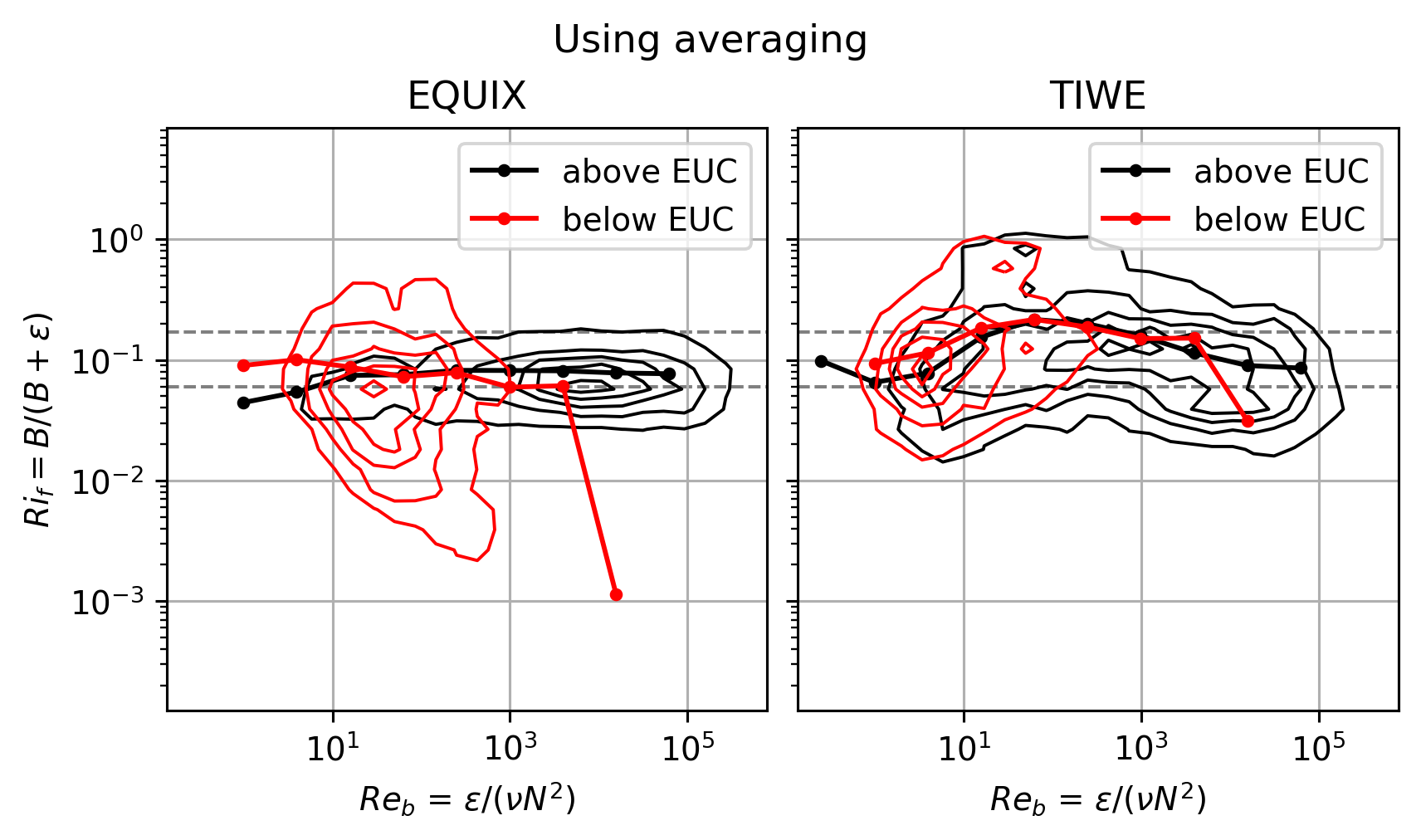
I think the combined dataset without paritioning by EUC max is a better view:
This figure relies on \(Re_b\) to pick out the DCL I guess.
EQUIX totally dominates TIWE for \(Re_b\) > 1000, so there might still be value in plotting each expt separately after paritioning at DCL depth
The errorbars are too small to be seen in log-space in the first plot
Show code cell source
def combined_average(*datasets, by, bins):
import functools
import operator
combined = xr.Dataset()
concat = xr.concat([ds[["Rif", by]] for ds in datasets], dim="time")
flox_kwargs = dict(expected_groups=(bins,), isbin=(True,), fill_value=np.nan)
for func in ["mean", "std", "count"]:
combined[f"{func}_Rif"] = flox.xarray.xarray_reduce(
concat, by, func=func, **flox_kwargs
).Rif
if by == "Reb":
combined["Rif_Reb_counts"] = functools.reduce(
operator.add, (ds.Rif_Reb_counts for ds in datasets)
).sum("euc_bin")
pump.plot.plot_rif_counts(combined.Rif_Reb_counts, x="Reb_bin", xscale="log")
else:
combined["Rif_Ri_counts"] = functools.reduce(
operator.add, (ds.Rif_Ri_counts for ds in datasets)
).sum("euc_bin")
pump.plot.plot_rif_counts(combined.Rif_Ri_counts, x="Ri_bin")
plt.errorbar(
x=[a.mid for a in combined[f"{by}_bins"].values],
y=combined.mean_Rif,
yerr=1.96 * combined.std_Rif / np.sqrt(combined.count_Rif),
marker=".",
label="mean $Ri_f$",
)
plt.suptitle("Combined TIWE + EQUIX")
plt.legend()
combined_average(tiwe, equix, by="Reb", bins=tiwe.Reb_bins_2.data)
plt.figure()
combined_average(
tiwe, equix, by="Ri", bins=[0, 0.05, 0.1, 0.15, 0.2, 0.25, 0.5, 0.6, 0.7, 1]
)
# plt.yscale("linear")
# plt.ylim([0, 1])
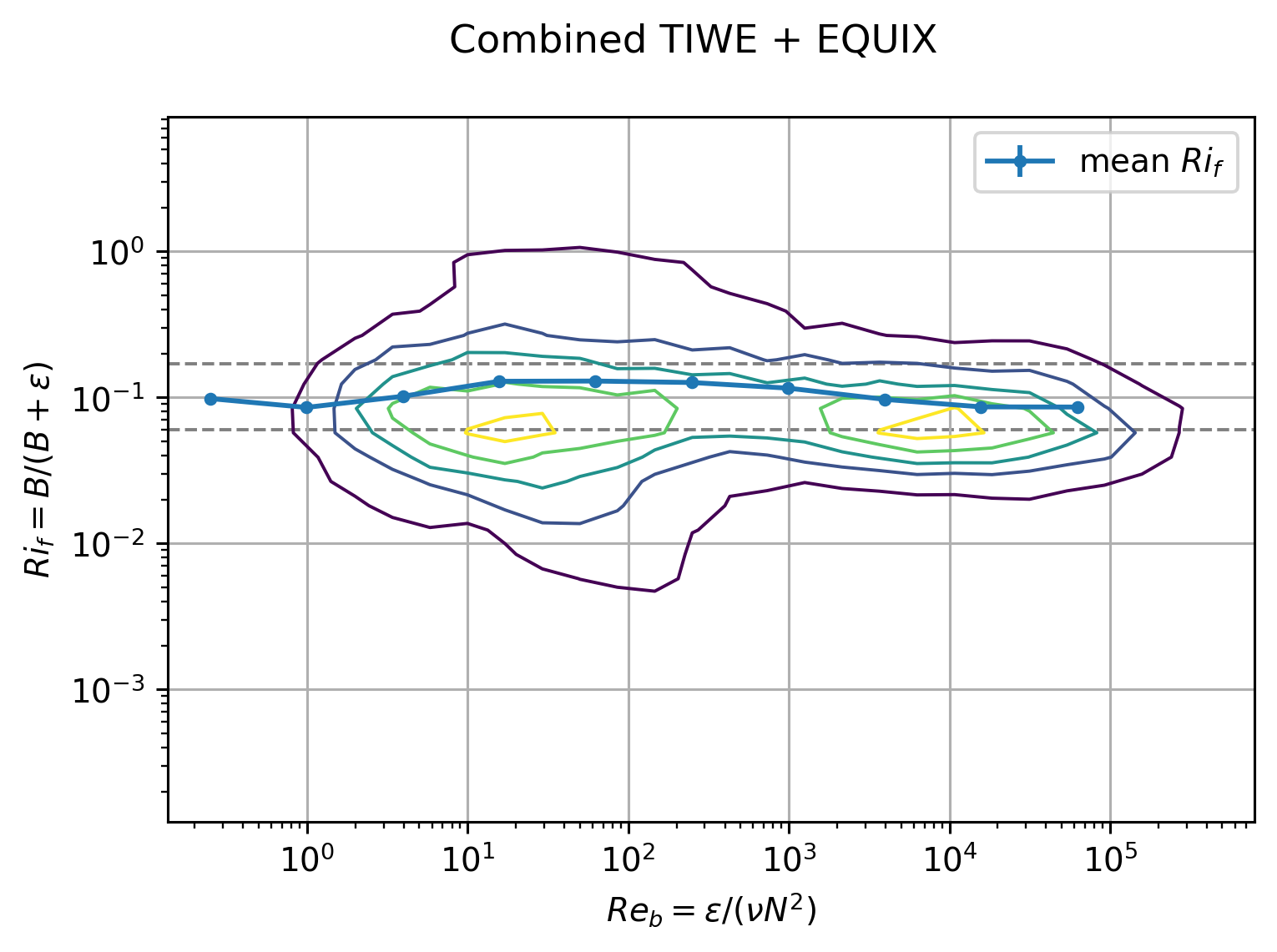
<Figure size 840x560 with 0 Axes>

Distributions of \(Re_b\) and \(Ri_f\)#
f, ax = plt.subplots(2, 1, sharex=False, sharey=False)
kwargs = dict(bins=np.arange(0, 0.7, 0.01), histtype="step", density=True)
equix.Rif.plot.hist(**kwargs, label="equix", ax=ax[0])
tiwe.Rif.plot.hist(**kwargs, label="tiwe", ax=ax[0])
ax[0].legend()
ax[0].set_xlabel("$Ri_f$")
kwargs = dict(bins=np.linspace(-1, 7, 100), histtype="step", density=True)
np.log10(equix.Reb).plot.hist(**kwargs, label="equix", ax=ax[1])
np.log10(tiwe.Reb).plot.hist(**kwargs, label="tiwe", ax=ax[1])
ax[1].legend()
ax[1].set_xlabel("log($Re_b$)")
Text(0.5, 0, 'log($Re_b$)')

Timeseries#
These timeseries are more meaningful. Black contours are \(Re_b\). White line is EUC max.
In TIWE, high \(Ri_f\) is seen near the base of the “DCL” i.e. when \(ε\) is generally low.
In EQUIX, \(ε\) is relatively high all the way down to the EUC max (disregarding details like upper core layer etc).
There’s a small amount of time on Nov. 4 where we see high \(Ri_f\) but \(Re_b\) looks about the same (but note \(Re_b\) is on a log scale).
TIWE Nov8-11; the DCL penetrates deeper, data indicate low \(Ri_f\) which seems consistent with EQUIX.
TIWE Nov. 7 contradicts the previous point (high \(ε\) at deeper depths but high \(Ri_f\))
Show code cell source
pump.plot.plot_mixing_diagnostics_timeseries(equix, coarsen=False)
pump.plot.plot_mixing_diagnostics_timeseries(tiwe, coarsen=False)
posx and posy should be finite values
posx and posy should be finite values

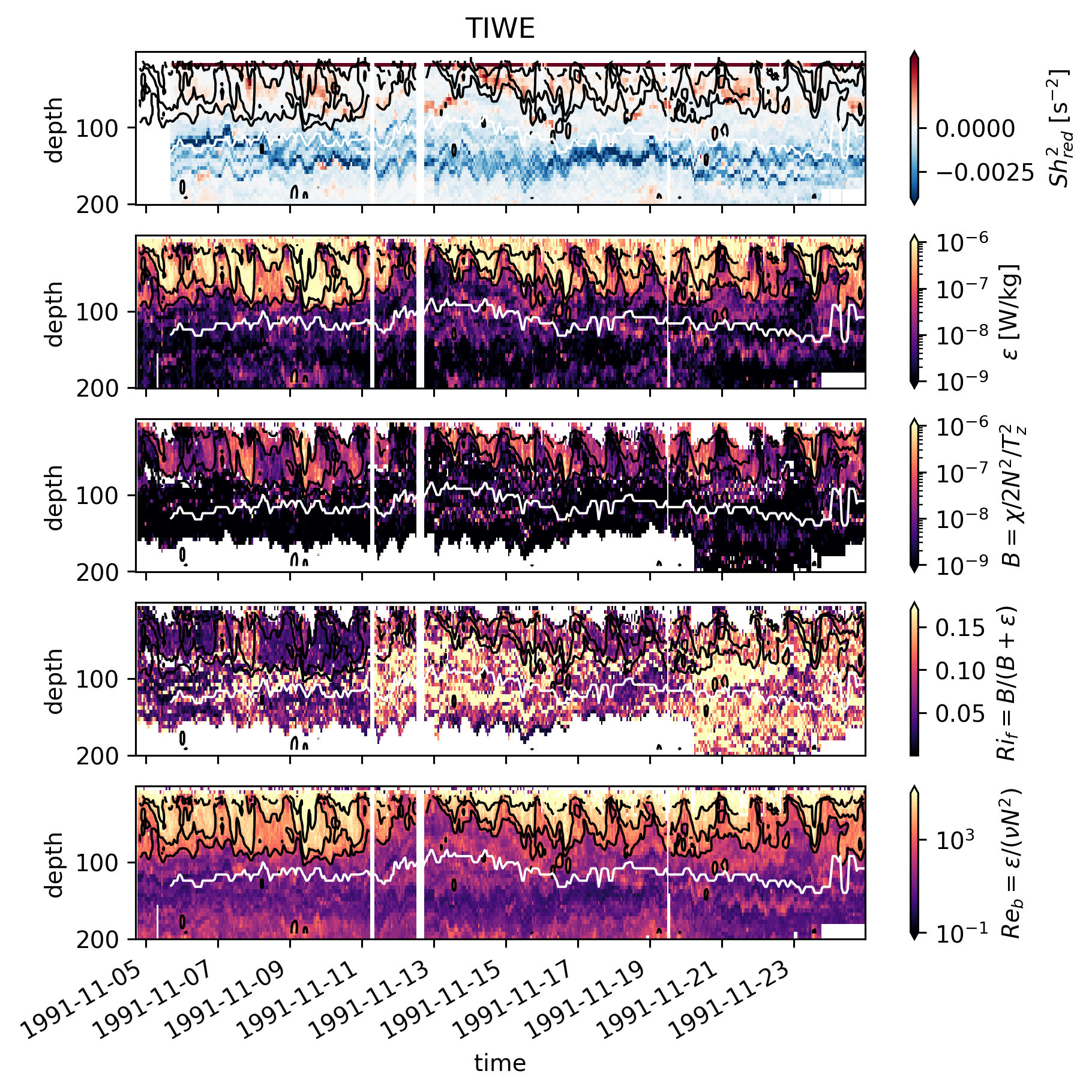
TIWE more closely#
First I divide the timeseries into a few periods (period = time instants where red line is flat). Then look at profiles of quantities averaged over those periods.
It turns out this is slightly misleading.
Show code cell source
section = xr.full_like(tiwe.eucmax, fill_value=np.nan)
section.attrs.clear()
section.attrs["long_name"] = "Period label"
breaks = [
None,
"1991-11-07 04:00",
"1991-11-08 06:00",
"1991-11-11 06:00",
"1991-11-17 09:00",
"1991-11-19 09:00",
None,
]
labels = [1, -1, 1, 2, 3, 4]
for label, left, right in zip(labels, breaks[:-1], breaks[1:]):
section.loc[{"time": slice(left, right)}] = label
tiwe.coords["section"] = section
tiwe.Rif.cf.plot(x="time", robust=True, cmap=mpl.cm.magma, vmax=0.17, size=5, aspect=4)
ax2 = plt.gca().twinx()
section.plot(ax=ax2, color="w", lw=5)
section.plot(ax=ax2, color="r", lw=2)
dcpy.plots.set_axes_color(ax2, "r")

It looks like the periods 1, 3, 4 (with the subsurface max in \(Ri_f\)) have a subsurface salinity max intrusion that might be limiting the deep-cycle.
Period 2 where most of the water column has high \(Ri_f\) looks weird in the profiles
BUT note that the base of the DCL seems to change quite a bit so the averaging might be confusing things
pretty broad Salinity intrusion below ~50m; \(Ri_f\) is relatively higher.
Peak \(Ri_f\) is just above the salinity max (or at the base of the DCL).
There is a strong gradient in ε, χ (base of the DCL)
But I see no signal of S intrusions in N^2?
Coincides with \(Re_b\) decreasing below 10^3 threshold for periods 1, 4; for period 3 the \(Re_b < 1000\)
Nov 7. is similar to Nov 5-6; 8-11; in all fields except \(χ\). Was there a sensor change?
Period 4 (after Nov. 20) has much higher χ (and higher \(T_z\)).
grouped = flox.xarray.xarray_reduce(
tiwe, "section", func="mean", expected_groups=[1, -1]
)
grouped.theta.attrs["long_name"] = "$θ$"
grouped["chi"] = grouped.chi.where(grouped.chi > 1e-9)
names = ["salt", "N2", "shred2", "dTdz", "chi", "eps", "Rif", "Reb"]
logx = ["chi", "eps", "Reb"]
linearx = ["Rif", "theta", "salt", "dTdz", "shred2"]
f, axx = plt.subplots(
1, len(names), sharey=True, constrained_layout=True, squeeze=False
)
ax = dict(zip(names, axx.squeeze()))
for name, axis in ax.items():
(grouped[name]).cf.plot.line(
ax=axis,
add_legend=name == names[0],
xscale="linear" if name in linearx else "log",
)
axis.grid(True)
f.set_size_inches((10, 5))
dcpy.plots.clean_axes(axx)
ax["chi"].set_xticks([1e-9, 1e-8, 1e-7, 1e-6])
ax["eps"].set_xticks([1e-8, 1e-7, 1e-6, 1e-5])
ax["dTdz"].set_xlim([-1e-2, 1e-1])
ax["shred2"].set_xlim([-1e-3, 1e-4])
ax["N2"].set_xlim([-1e-5, 1e-3])
ax["Reb"].set_xticks([1e2, 1e3, 1e4, 1e5]);
/Users/dcherian/mambaforge/envs/pump/lib/python3.10/site-packages/flox/aggregate_flox.py:103: RuntimeWarning: invalid value encountered in true_divide
out /= nanlen(group_idx, array, size=size, axis=axis, fill_value=0)
/var/folders/yp/rzgd0f7n5zbcbf5dg73sfb8ntv3xxm/T/ipykernel_12250/1338187074.py:27: UserWarning: Attempted to set non-positive left xlim on a log-scaled axis.
Invalid limit will be ignored.
ax["N2"].set_xlim([-1e-5, 1e-3])
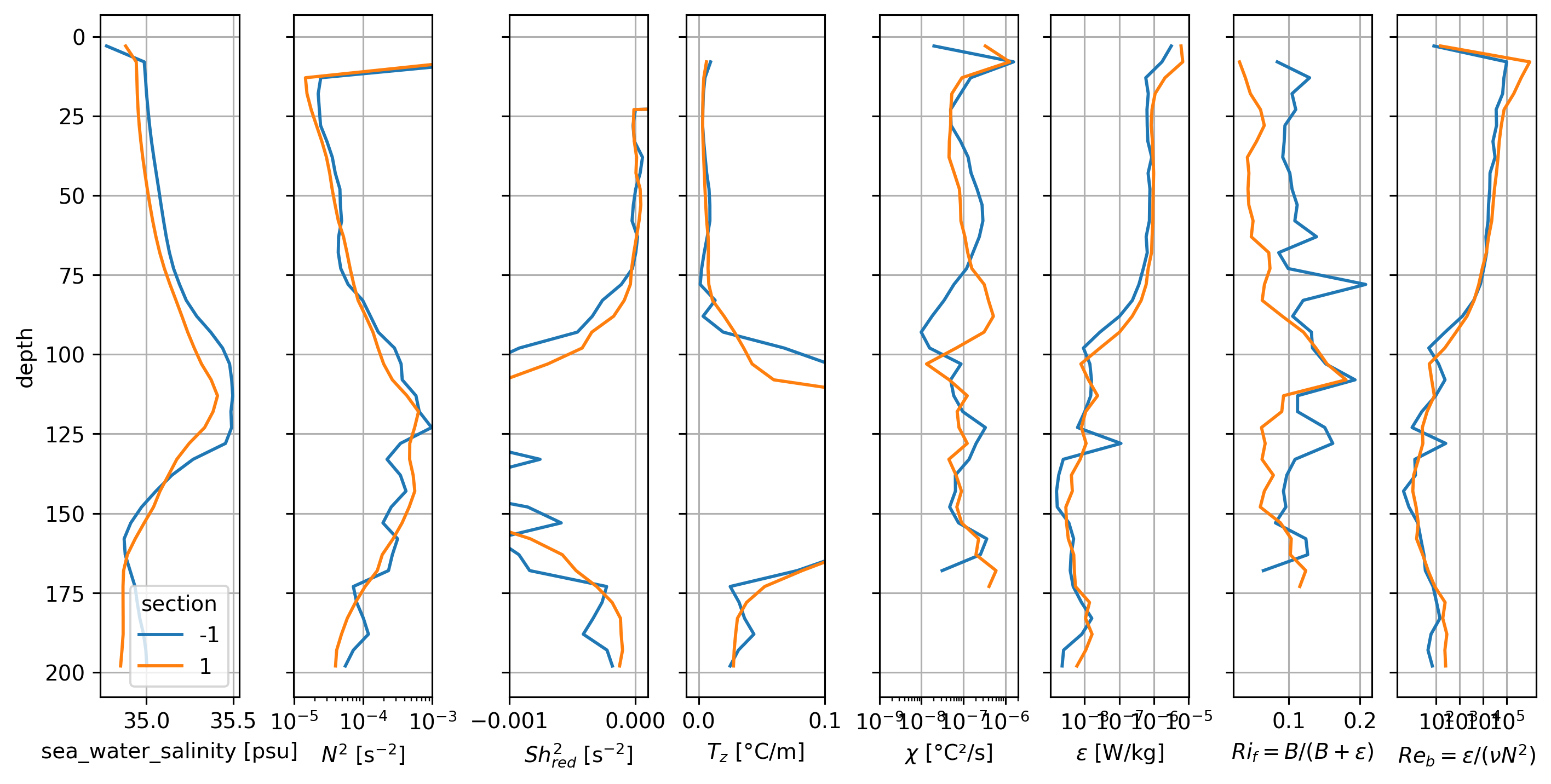
grouped = flox.xarray.xarray_reduce(
tiwe, "section", func="mean", expected_groups=[1, 3, 4]
)
grouped.theta.attrs["long_name"] = "$θ$"
grouped["chi"] = grouped.chi.where(grouped.chi > 1e-9)
names = ["salt", "N2", "shred2", "dTdz", "chi", "eps", "Rif", "Reb"]
logx = ["chi", "eps", "Reb"]
linearx = ["Rif", "theta", "salt", "dTdz", "shred2"]
f, axx = plt.subplots(
1, len(names), sharey=True, constrained_layout=True, squeeze=False
)
ax = dict(zip(names, axx.squeeze()))
for name, axis in ax.items():
(grouped[name]).cf.plot.line(
ax=axis,
add_legend=name == names[0],
xscale="linear" if name in linearx else "log",
)
axis.grid(True)
f.set_size_inches((10, 5))
dcpy.plots.clean_axes(axx)
ax["chi"].set_xticks([1e-9, 1e-8, 1e-7, 1e-6])
ax["eps"].set_xticks([1e-8, 1e-7, 1e-6, 1e-5])
ax["dTdz"].set_xlim([-1e-2, 1e-1])
ax["shred2"].set_xlim([-1e-3, 1e-4])
ax["N2"].set_xlim([1e-6, 1e-3])
ax["Reb"].set_xticks([1e2, 1e3, 1e4, 1e5]);
/Users/dcherian/mambaforge/envs/pump/lib/python3.10/site-packages/flox/aggregate_flox.py:103: RuntimeWarning: invalid value encountered in true_divide
out /= nanlen(group_idx, array, size=size, axis=axis, fill_value=0)
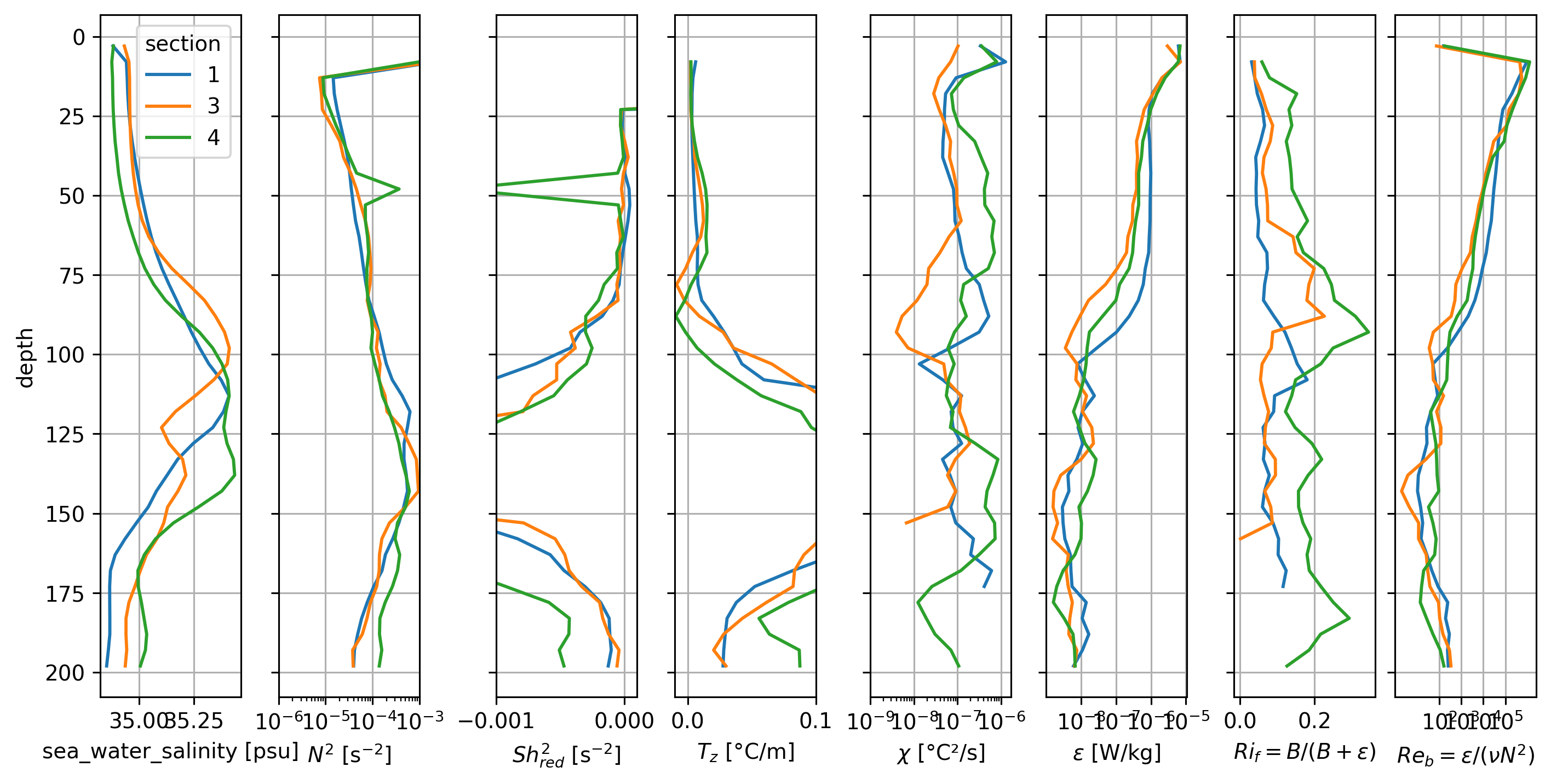
TIWE dTdz is low, so it makes sense that salinity field is influencing DCL depth.
tiwe.dTdz.mean("time").cf.plot.line(label="tiwe $T_z$")
equix.dTdz.mean("time").cf.plot.line(label="equix $T_z$")
tiwe.N2.mean("time").cf.plot.line(ls="--")
equix.N2.mean("time").cf.plot.line(xscale="log", ls="--")
plt.legend()
<matplotlib.legend.Legend at 0x17930a260>
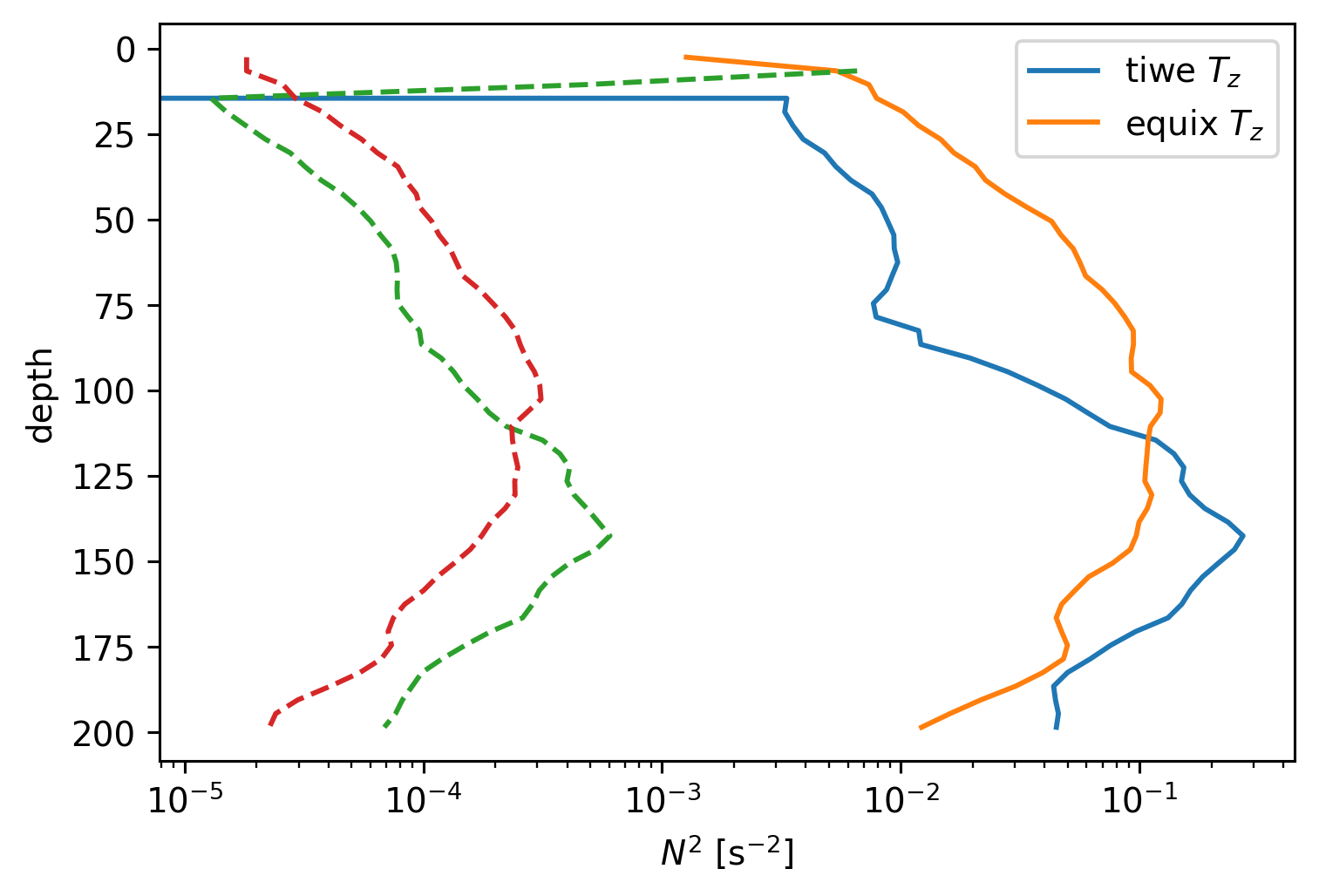
A bunch of fields#
equix.dTdz.cf.plot(norm=mpl.colors.LogNorm(1e-3, 1e-1))
plt.figure()
tiwe.dTdz.cf.plot(norm=mpl.colors.LogNorm(1e-3, 1e-1))
<matplotlib.collections.QuadMesh at 0x180ab1360>
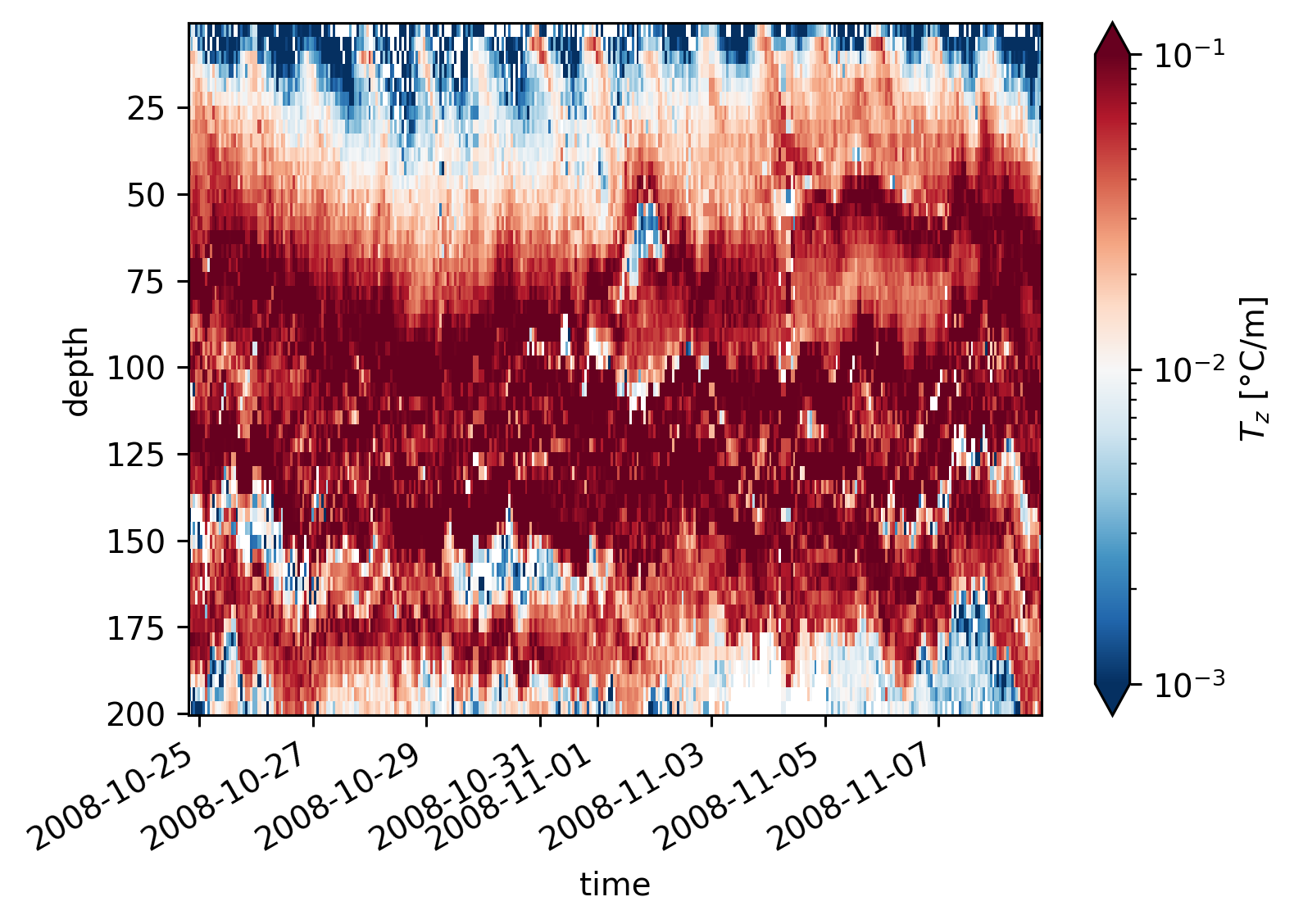

equix.N2.cf.plot(norm=mpl.colors.LogNorm(1e-6, 1e-3))
plt.figure()
tiwe.N2.cf.plot(norm=mpl.colors.LogNorm(1e-6, 1e-3))
<matplotlib.collections.QuadMesh at 0x1819a4f10>
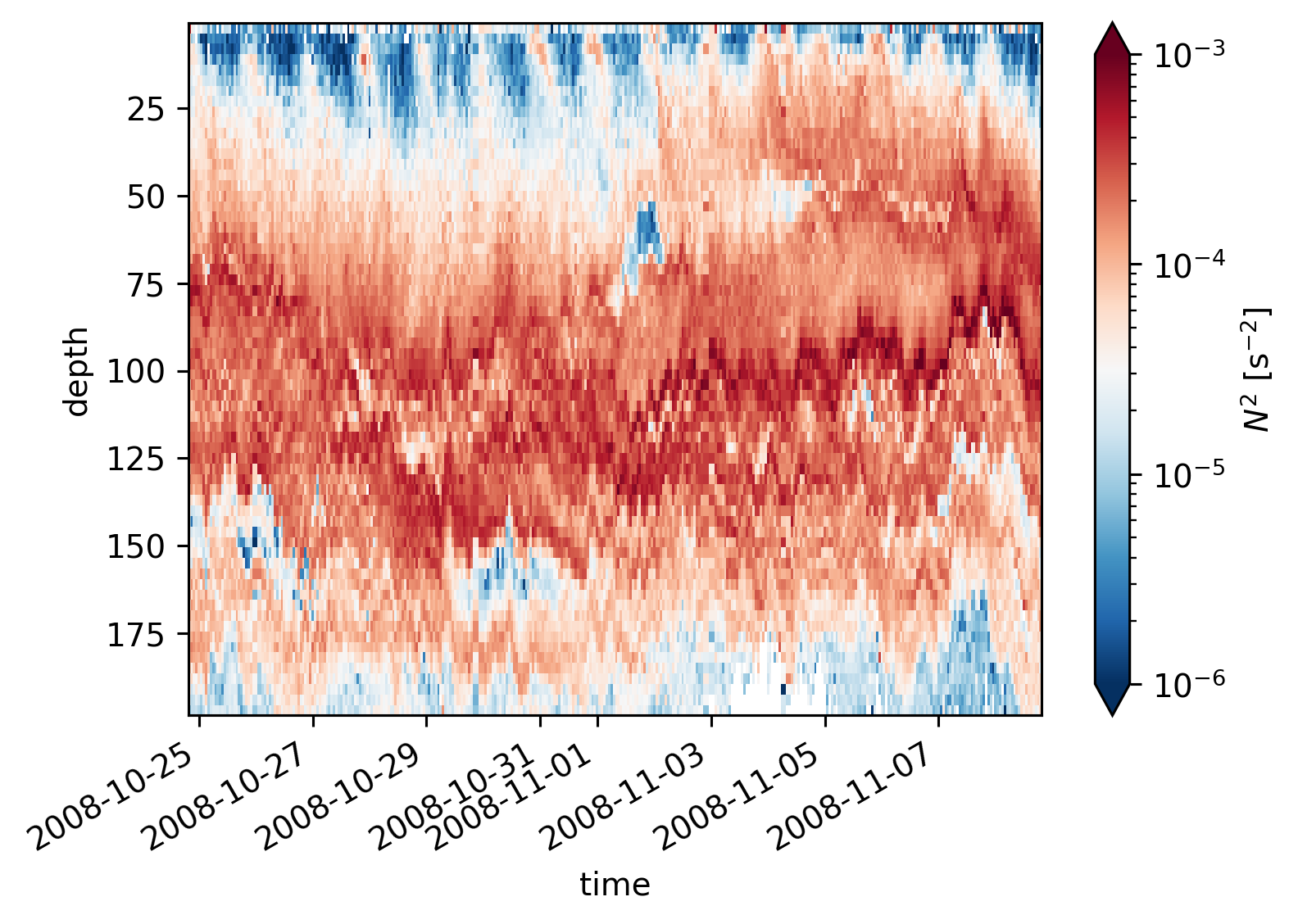
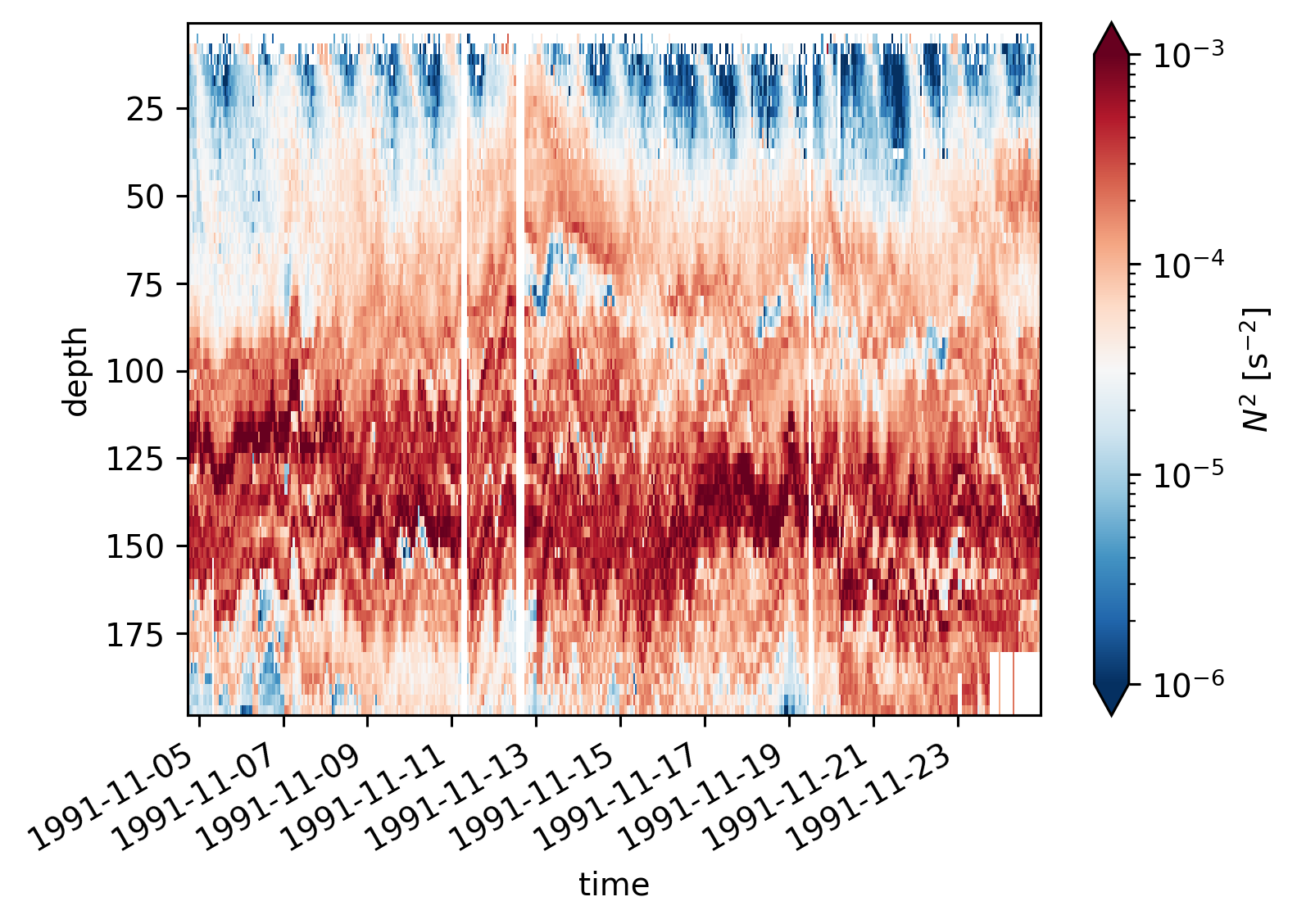
equix.shred2.cf.plot(norm=mpl.colors.TwoSlopeNorm(vmin=-4e-3, vcenter=0, vmax=5e-4))
plt.figure()
tiwe.shred2.cf.plot(norm=mpl.colors.TwoSlopeNorm(vmin=-4e-3, vcenter=0, vmax=5e-4))
<matplotlib.collections.QuadMesh at 0x180ada950>
posx and posy should be finite values
posx and posy should be finite values
